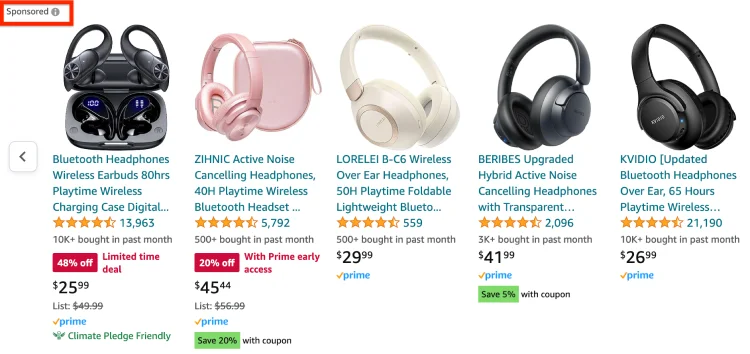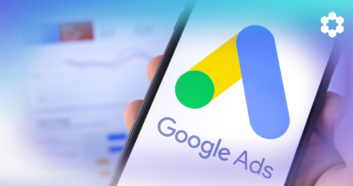In Part 2 of our comprehensive guide on How to Rank Organically on Amazon in 2024, we delved into the intricacies of external traffic and paid campaigns. By combining the strengths of paid and organic marketing efforts, you can maximize your presence on Amazon and achieve sustainable success.
In Part 3, we’ll explore Amazon Pay-Per-Click (PPC) advertising. We’ll unravel how Amazon PPC works and provide actionable insights on leveraging it to improve organic traffic and rankings.
Overall, mastering Amazon PPC allows you to boost visibility, drive traffic and sales, compete effectively, optimize budget allocation, and ultimately improve organic ranking – all critical factors for Amazon success.
How Does Amazon PPC Work?
Amazon PPC works on a bidding system where you bid on keywords relevant to your products. When a shopper searches for a keyword, Amazon’s algorithm selects and displays relevant ads based on bid amount and ad relevance.
You only pay when your ad is clicked. For example, if you bid on the keyword “portable blender” and a shopper searches for that term, your ad may appear at the top of the search results.
If the shopper clicks on the ad, you pay the bid amount for that click. Other examples include sponsored product ads displayed within search results or on product detail pages, sponsored brand ads appearing at the top of search results, and sponsored display ads shown on product detail pages or in the Amazon Demand-Side Platform (DSP) network. More on that later.
PPC Traffic Sources
There are three types of Amazon PPC traffic sources that you can direct to your listings.
1. Sponsored Products
Keyword-targeted ads appear within Amazon’s search results and on product detail pages. Sellers bid on specific keywords, displaying their ads when shoppers search for those keywords. For instance, if someone searches for “wireless headphones,” sponsored product ads for relevant headphone listings may appear at the top of the search results.

There are two types of targeting strategies for Sponsored Product Ads: automatic targeting and manual targeting.
Automatic Targeting
In automatic targeting, Amazon’s algorithm determines where ads are displayed based on relevant keywords, product categories, and shopper behavior. Amazon automatically matches your ads with search terms and products relevant to your listing. For example, if you’re selling a yoga mat, Amazon might display your ad when a shopper searches for “yoga accessories” or views similar yoga mats.
Keyword Match Types
In automatic Sponsored Product Ads targeting strategy, there are four different keyword match types:
- Broad Match: Ads are displayed for search terms that contain the exact keyword or variations, including misspellings, synonyms, and related searches. This match type provides the widest reach but could result in fewer relevant clicks.
- Phrase Match: Ads are shown for search terms with exact keywords or close variations in the same order. The search query can have additional words before or after the keyword, but the keyword phrase must remain intact. This match type offers a balance between reach and specificity.
- Exact Match: Ads are only triggered when the search query exactly matches the keyword or close variations. Remove additional words before, after, or between the keyword terms. This match type provides the highest level of precision and is ideal for targeting definitive search queries.
- Negative Match: Negative keywords prevent ads from being displayed in certain search terms. When a negative keyword is added, the ad won’t show if the search query contains that keyword. A negative match type helps refine ad targeting and ensures ads are not shown for irrelevant or unwanted searches.
Manual Targeting
Manual targeting gives you more control over which keywords and products trigger your ads. You can choose specific keywords or ASINs to target, allowing for more precise ad placements. For instance, if you’re selling a fitness tracker, you can target keywords like “fitness watch” or specific competing products’ ASINs to appear alongside relevant search results or product pages.
Sponsored Brand
These ads (video, photo, infographic) feature a custom headline, logo, and multiple products. They appear at the top of search results and can help increase brand visibility and recognition.
An example would be a search for “women’s running shoes.” A sponsored brand ad for a sports apparel brand would appear showcasing one or more shoe models at the top of the search results page.

These ads allow you to reach potential customers on and off Amazon by displaying targeted ads to shoppers interested in similar products.
Examples of Sponsored Display ads include:
- Product Recommendation Ads: These ads appear on Amazon product detail pages and recommend related or complementary products to shoppers based on their browsing or purchase history. For example, a shopper who is viewing a laptop on Amazon may see a Sponsored Display ad suggesting laptop accessories such as a laptop stand or mouse pad.
- Retargeting Ads: These ads target shoppers who have previously visited your website or viewed specific products but did not make a purchase. For example, a shopper visits a clothing retailer’s website and browses a selection of jackets, they may later see Sponsored Display ads for those jackets as they browse other websites or apps within Amazon’s advertising network.
- Custom Ads: You can create custom Sponsored Display ads tailored to your specific marketing objectives and target audience. These ads can include custom messaging, branding elements, and calls to action to drive engagement and conversions. For example, a beauty brand may create a custom Sponsored Display ad promoting a limited-time discount on skincare products to target customers interested in skincare.
Sponsored Display ads offer a versatile solution to reach and engage potential customers on and off the Amazon platform, driving awareness, consideration, and sales for your products and brands.
Differences between On-Amazon and Off-Amazon Ad Platforms
On-Amazon and external ad platforms have distinct purposes, and pros and cons.
Amazon PPC
Amazon PPC is specifically designed for advertising products directly on the Amazon platform. It allows you to promote your products within Amazon’s search results, product pages, and other relevant placements.
Pros
- Targeted Audience: Ads are shown to users actively searching for products on Amazon, increasing the likelihood of conversion.
- Integration: Seamlessly integrates with Amazon’s ecosystem, allowing for easy management of campaigns and access to detailed performance metrics.
- Product Visibility: Helps improve product visibility within Amazon’s marketplace, potentially leading to increased sales.
Cons
- Limited Reach: Ads are only visible to users within the Amazon platform, limiting the audience reach compared to external ad platforms.
- Competition: High competition among sellers on Amazon can drive up advertising costs, making it challenging to maintain profitability.
External PPC Platforms
External ad platforms like Google Ads and Meta Ads, allow you to reach audiences outside the Amazon ecosystem. They provide opportunities to advertise products or services across various websites, search engines, and social media platforms.
Pros
- Broad Audience Reach: External ad platforms offer access to a vast audience beyond Amazon’s marketplace, allowing for increased brand exposure and potential customer acquisition.
- Diverse Ad Formats: Different platforms support various ad formats, including text ads, display ads, video ads, and more, providing flexibility in campaign creatives.
- Advanced Targeting Options: External platforms often offer sophisticated targeting capabilities based on demographics, interests, behaviors, and more.
Cons
- Learning Curve: Managing campaigns on external ad platforms may require a learning curve, as each platform has its interface, features, and best practices.
- Audience Intent: Unlike Amazon PPC, where users actively search for products, audiences on external platforms may not have purchase intent, leading to lower conversion rates.
- Cost Management: Ad costs on external platforms can vary significantly based on factors like competition, targeting criteria, and ad quality, requiring careful budget management.
Choosing between on-Amazon PPC and external ad platforms depends on various factors such as your advertising goals, target audience, budget, and product offering. On-Amazon PPC makes sense for sellers looking to maximize visibility within Amazon’s marketplace and leverage the platform’s active user base.
However, if you aim to expand your reach beyond Amazon and engage with a broader audience, external ad platforms can offer valuable opportunities for brand exposure and customer acquisition. Ultimately, leveraging both on-Amazon and off-Amazon advertising may provide the most comprehensive approach to advertising, allowing you to reach diverse audiences across different channels.
Amazon PPC Mastery: Using Amazon PPC to Increase Organic Traffic

Incorporating Amazon PPC into your marketing strategy can yield significant benefits, such as targeted reach, enhanced visibility, insights into high-performing keywords to include in your organic ranking optimization strategy, accelerated sales velocity, and more.
Here’s how to effectively integrate Amazon PPC with your organic marketing strategy to increase traffic.
1. Set Clear Objectives
Define your campaign goals, whether it’s increasing sales, driving brand awareness, or maximizing profitability. Clear objectives will guide your strategy and help measure success.
2. Keyword Research Alignment
Align your Amazon PPC campaigns with your organic keyword strategy. Identify high-performing keywords that drive organic traffic and use them in your PPC campaigns to target relevant audiences effectively.
Consider using Amazon’s Keyword Research Tool and third-party tools like PixelMe (for off-Amazon campaigns) and PPC Entourage (for Amazon PPC) to discover high-converting keywords with appropriate search volume and low competition.
3. Structure Your Campaigns
Structuring Amazon PPC campaigns for increased organic traffic involves meticulous keyword research, organizing keywords into focused ad groups, and crafting compelling ad copy. Using a mix of match types and negative keywords helps refine targeting and prevent wasteful spending. Bidding strategies should align with campaign goals, with continuous monitoring and optimization based on performance metrics.
4. Set Budgets and Bids
Determine your daily and campaign-level budgets based on your advertising goals and overall marketing budget. Your strategy around estimated return on ad spend (ROAS) is crucial, especially with limited ad budgets.
ROAS measures the revenue earned in sales for every dollar spent on ads. Different ad types and strategies yield varying ROAS levels. For instance, Sponsored Brand ads and exact or broad match types often generate the highest sales. Product pricing also influences ROAS, with products in the $20-$30 range achieving optimal returns in most cases. While optimizing PPC campaigns takes time and practice, understanding the potential return on investment can inform decision-making.
In the initial stage, establish daily budgets and default bids at levels exceeding Amazon’s suggested figures by 50-100%. Sign up for a free trial of PPC Entourage to get an ad spend audit to minimize unnecessary expenses while maximizing budget efficiency.
Overall, navigating through various PPC strategies can be challenging initially, particularly for small and medium-sized sellers managing PPC bids. Experimenting with different ad types leads to identifying what works best for your brand. Analyzing data can eliminate underperforming ads while scaling up successful ones, polishing your overall PPC approach over time.
5. Choose the Right Ad Types
Amazon offers various ad types, including Sponsored Products, Sponsored Brands, and Sponsored Display ads. Select the ad formats that best suit your objectives and audience targeting strategy.As mentioned above, consider experimenting with all available ad formats, especially automatic-targeting ads and manually targeting Sponsored Products ads. These options provide valuable insights into the keywords and search terms that relate best with your Amazon audience. Alternatively, Sponsored Brand ads allow you to showcase multiple formats in a single ad, making them ideal for increasing brand visibility and driving traffic to your Amazon storefront or product listings.
6. Optimize Product Listings
Ensure your product listings are optimized for relevant keywords, high-quality images, compelling titles, and detailed descriptions. A well-optimized product page enhances ad relevance and improves click-through rates.Ensure that your product listings are fully optimized before running PPC campaigns. This includes optimizing titles, bullet points, descriptions, and images that maximize conversions organically and through PPC ads.
Start optimizing your listing visuals with ContentPlus! Transform current images into new lifestyle snapshots and review videos to highlight your products, driving increased sales and outshining your rivals in the market.
7. Integrate with Content Strategy
Incorporate PPC campaigns into your content strategy by promoting blog posts, videos, or other content that drives traffic to your Amazon listings. This can help increase brand awareness and engagement while driving organic traffic and sales.
8. Monitor Performance Metrics
Amazon PPC campaigns involve various metrics that help you measure the performance and effectiveness of your advertising efforts. Here are some key metrics and how to track them:
Clicks
Clicks represent the number of times users click on your ad. This metric indicates the level of interest and engagement generated by your ad. Clicks can be tracked within the Amazon Advertising console or through third-party analytics tools. For example, if your Sponsored Product ad receives 100 clicks in a day, it means your ad has been clicked on 100 times by users.
Impressions
Impressions refer to the number of times your ad is displayed to users. It measures the visibility of your ad on the Amazon platform. Impressions can be tracked within the Amazon Advertising console. For instance, if your Sponsored Brand ad receives 1,000 impressions, that means it’s been shown to users 1,000 times.
Click-Through Rate (CTR)
CTR is the ratio of clicks to impressions, expressed as a percentage. It measures the effectiveness of your ad in generating clicks relative to its visibility. CTR can be calculated by dividing the number of clicks by the number of impressions and multiplying by 100. For example, if your ad receives 100 clicks and 1,000 impressions, your CTR would be 10%.
Cost-Per-Click (CPC)
CPC represents the average cost incurred for each click on your ad. It indicates how much you are paying for user engagement. CPC can be calculated by dividing the total cost of the campaign by the number of clicks. For example, if your campaign costs $100 and gets 50 clicks, your CPC would be $2.
Conversion Rate (CR)
Conversion rate measures the percentage of users who complete a desired action after clicking on your ad, like making a purchase or signing up for a newsletter. It indicates the effectiveness of your ad in driving conversions. Conversion rates can be tracked using conversion tracking tools or by analyzing sales data. For example, if your ad generates 10 conversions out of 100 clicks, your conversion rate would be 10%.
Advertising Cost of Sales (ACOS)
ACOS represents the ratio of advertising spend to attributed sales, expressed as a percentage. It measures the efficiency of your ad campaigns in generating sales relative to the advertising cost. ACOS can be calculated by dividing the total ad spend by attributed sales and multiplying by 100. For example, if your ad spend is $200 and generates $1,000 in sales, your ACOS would be 20%.
Tracking these metrics enables you to assess the performance of your Amazon PPC campaigns, optimize targeting and bidding strategies, and maximize return on investment.
How to Audit PPC Traffic
Auditing Amazon PPC metrics involves analyzing each metric to assess the performance of your advertising campaigns to identify areas for improvement. Here’s how to audit each metric effectively:
Clicks
- Audit the total number of clicks your ads have received over a specific period.
- Compare the click volume to previous periods to identify trends and fluctuations.
- Analyze the click distribution across different ad campaigns, groups, and keywords.
- Any anomalies or sudden changes in click volume could indicate an issue with targeting or ad relevance.
Impressions
- Review the total number of impressions your ads have generated.
- Compare impression data across different campaigns and ad placements.
- Assess the impression share to determine the percentage of available impressions your ads receive.
- Identify any ad groups or keywords with low impression volume that may require optimization.
CTR
- Calculate the CTR for each ad campaign, ad group, and keyword.
- Compare CTR data to industry benchmarks and historical performance.
- Look for ad creatives, keywords, or targeting strategies with high CTRs and replicate their success.
- Identify underperforming elements affecting CTR, such as irrelevant keywords or ad copy.
CPC
- Review the average CPC for each ad campaign and ad group.
- Compare CPC data across different campaigns and keyword match types.
- Assess the impact of bid adjustments and keyword competition on CPC.
- Look for opportunities to lower CPC by optimizing keyword selection, ad targeting, and bid strategies.
Conversion Rate
- Analyze the conversion rate for each ad campaign, ad group, and keyword.
- Compare CR data across different product categories and campaign objectives.
- Identify top-performing keywords and ad creatives with high conversion rates.
- Evaluate the effectiveness of landing pages and product detail pages in driving conversions.
ACoS
- Calculate the ACoS for each ad campaign and ad group.
- Compare ACoS data to your target ACoS and profitability goals.
- Identify campaigns or keywords with high ACoS that may be unprofitable.
- Adjust bids, budgets, and targeting settings to improve ACoS and maximize return on investment.
Use Carbon6’s 3-part ASIN insight tool to discover which off-Amazon ads perform best for you. Monitor your ROI across your Amazon investments and replicate success. Utilize this tool here.
9. Test and Iterate
Implement A/B testing to experiment with different ad creatives, targeting options, and bidding strategies. Continuously optimize campaigns based on performance data and insights to refine your PPC strategy over time.
10. Leverage Data Analytics
Utilize analytics tools like D8aDriven to gain valuable insights into customer behavior, search trends, and competitor performance. Use this data to make informed decisions and adjust your PPC strategy accordingly.
11. Stay Updated with Best Practices
Keep abreast of Amazon’s advertising policies, algorithm changes, and industry trends to stay competitive. Regularly review and tweak your PPC strategy to adapt to evolving market conditions and consumer preferences.
By following Amazon PPC mastery tips and continuously refining your approach based on performance insights, you can develop successful Amazon PPC tactics and strategies that drive traffic, boost sales, and maximize ROI for your business.
How Long to Run Amazon PPC Campaigns?
Determining the optimal duration for running Amazon PPC campaigns depends on various factors (see below). It’s advisable to run campaigns continuously but with regular monitoring and adjustments to ensure effectiveness. However, here’s a breakdown of considerations:
- Campaign Goals: Align the campaign duration with specific objectives, such as product launches, promotions, seasonal events, or ongoing brand awareness. Short-term goals may require shorter campaign durations, while long-term objectives may necessitate ongoing campaigns.
- Budget Allocation: Consider your budget constraints and allocate resources accordingly. Running campaigns continuously may be feasible if the budget allows, but with limited resources, prioritize high-impact periods or target audience segments.
- Product Lifecycle: Adjust campaign duration based on the product’s lifecycle stage (introduction > growth > maturity > decline). For new products, longer campaigns may be necessary to build awareness and momentum, while established products may benefit from shorter, focused campaigns to maintain visibility.
- Market Dynamics: Stay attuned to market trends, competitor activity, and consumer behavior. Flexibility in campaign duration allows for timely adjustments in response to market shifts or competitive pressures.
- Performance Monitoring: Regularly monitor campaign performance metrics. Use this data to assess campaign effectiveness and determine whether to continue, pause, or modify campaigns.
The ideal duration for Amazon PPC campaigns varies based on specific objectives, budget considerations, product lifecycle stage, market dynamics, and performance monitoring. Continuous monitoring and optimization are essential to maximize campaign effectiveness and adapt to changing conditions.
Core Insights for Boosting Organic Ranking
Outranking your competitors requires continual optimization in crucial areas to ensure long-term success. You must consistently take proactive steps to increase visibility and attract customers.
Embrace these essential strategies to enhance organic ranking on Amazon and witness a visibility surge in 2024. Here’s a summary of our tips for securing organic ranking supremacy:
- Use language that connects with your customers: Ensure that the key information on your product listings, such as title and product description, align with your target audience’s search terms. Increase clicks and conversion by refining titles, keywords, and images through meticulous A/B testing.
- Invest in off-Amazon ad campaigns: Establish domain authority through high-quality content and the acquisition of backlinks from affiliates or partners.
- Embrace innovation: Utilize emerging features like video and Enhanced Brand Content to gain an edge.
- Harness Amazon PPC campaigns: Run targeted Amazon PPC campaigns to drive traffic and bolster organic rank.
- Leverage social promotion: Spread the word on social media and other platforms to accelerate organic growth.
- Address technical factors: Positively impact rankings by optimizing site speed and indexing.
- Monitor closely: Keep a vigilant eye on rankings and sales data to refine strategies and adapt accordingly.
Amazon PPC Mastery: The Path to Long-Term Growth
Amazon PPC mastery is essential for sustainable success in the fiercely competitive marketplace. By leveraging Amazon’s advertising platform effectively, you can boost visibility, drive traffic and sales, and compete effectively against competitors. However, success requires continuous optimization and adaptation to stay ahead of the curve.
Staying up-to-date with Amazon’s features and trends is crucial for winning. By experimenting with different ad types, targeting strategies, and bidding tactics, you can identify what works best for your brand and refine your approach over time. Additionally, integrating PPC campaigns with organic marketing can amplify results and drive long-term growth.
Continuous optimization using ecommerce solutions like SellerTools, ContentPlus, PixelMe, PPC Entourage, and D8aDriven is key for long-term success. By setting (and adjusting) clear objectives, conducting thorough keyword research, optimizing listings for PPC, structuring campaigns effectively, and monitoring performance metrics closely, you can maximize the effectiveness of your ad campaigns and achieve optimal results.
Ultimately, a combination of on-Amazon and off-Amazon advertising can provide the most comprehensive approach to advertising, allowing you to reach diverse audiences across different channels. Remember to stay customer-focused and data-driven to easily navigate the complexities of Amazon PPC and unlock the maximum potential of your online presence.




